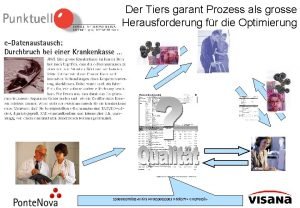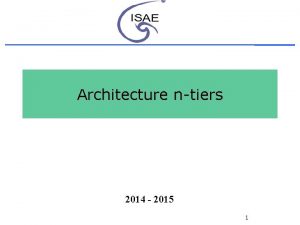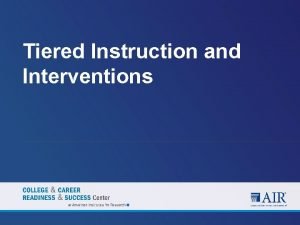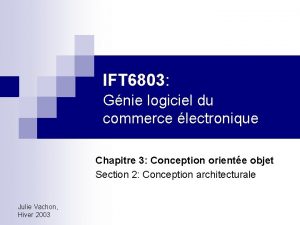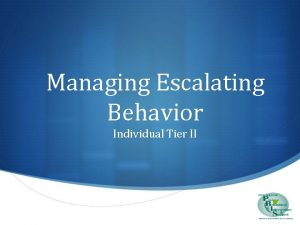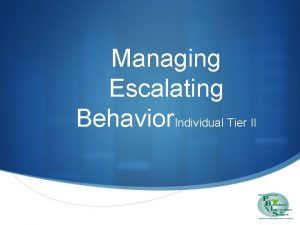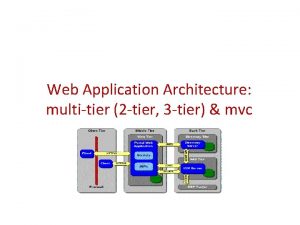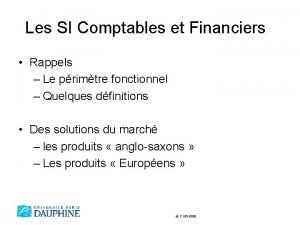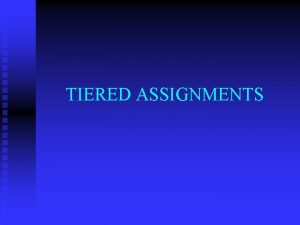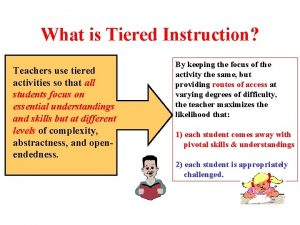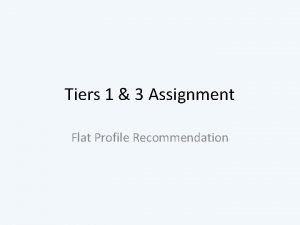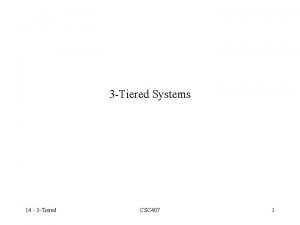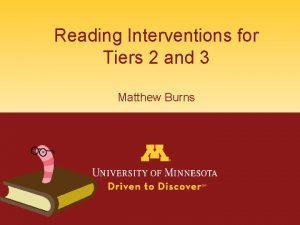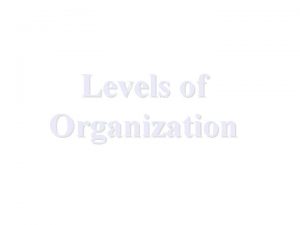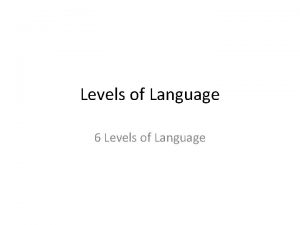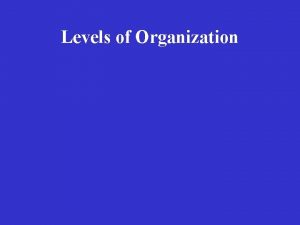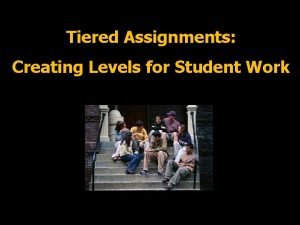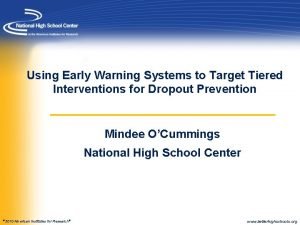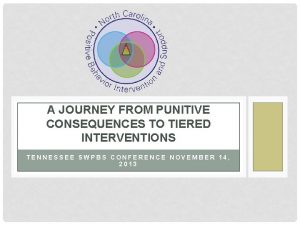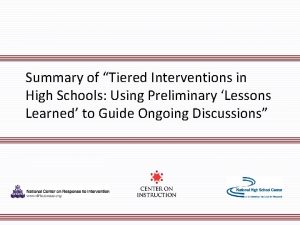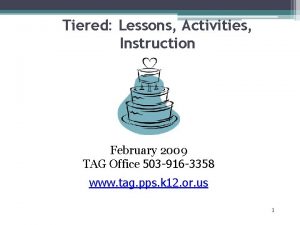Tiered Instruction and Interventions Levels Tiers and Interventions


















- Slides: 18

Tiered Instruction and Interventions

Levels, Tiers, and Interventions Tier III Tier II MODEL: Minimum of 3 tiers representing each level of intensity Tier I 2

Levels, Tiers, and Interventions Tier III Tier I Interventions are provided at each level and within each tier.

Tiered Interventions § Interventions need to be aligned to focus area. § Secondary schools tend to skip ensuring strong Tier I and focus on Tier II and Tier III supports. § Establish exit and entry criteria for students. 4

Potential Resources § Center on Instruction • Bringing Literacy Strategies into Content Instruction – www. centeroninstruction. org/bringing literacy strategies into content instruction • Response to Intervention resources § Center on Innovations in Learning content on personalized learning effective practices – http: //www. centeril. org/TOOLSTRAININGMODULES/ § The IRIS Center module on differentiated instruction – http: //iris. peabody. vanderbilt. edu/iris resource locator/? term=differentiated instruction § Handout on creating tiered intervention framework 5

Tier II 6

Tier II Level § FOCUS: Students identified through screening as at risk for poor learning outcomes § INSTRUCTION: Targeted, supplemental instruction delivered to small groups § SETTING: General education classroom or other general education location within the school § ASSESSMENTS: Progress monitoring, diagnostic

Tier II Focus § Students identified through screening as at risk for poor learning outcomes § Typically 15% of entire population

Tier II Instruction § Evidence based § Aligns with and supports core instruction § Implementation fidelity based on developer guidelines. § Delivered by well trained staff in optimal group sizes § Decisions are based on valid and reliable data and criteria are implemented accurately. § Supplements core instruction

Tier II Setting § General education classroom or similar setting § Adult led instruction § Small group rather than whole class

Tier II Assessment § Decisions about responsiveness to intervention • Are based on reliable and valid progress monitoring data. • Reflect judgment based on the slope of improvement or final status at the end of the intervention period. § Decision making rules are applied accurately and consistently

Tier II Assessment § Progress monitoring • • • Monitor student response to secondary instruction. Evaluate the efficacy of the secondary system. Conduct at least monthly. § Diagnostic assessment • Match students needs to interventions.

Example of Interventions Aligned With EWS Indicators: Attendance Tier III Intensive Tier II Targeted Tier I Universal Type of Intervention Attendance Universal (all students) § § Targeted (15% to 20% of students) § Two or more unexcused absences in a month brings brief daily check by an adult § Attendance team (teacher, counselor, administrator, parent) investigates and problem solves (why isn’t student attending? ) Intensive (5% to 10% of students) § Sustained one on one atten tion and problem solving § Appropriate social service community supports Every absence brings a response A culture exists that says attending every day matters Positive social incentives for good attendance Data tracking by teacher teams Source: Mac Iver & Mac Iver, 2009 13

Example of Interventions Aligned With EWS Indicators: Behavior Tier III Intensive Tier II Targeted Tier I Universal Type of Intervention Behavior Universal (all students) § § Targeted (15% to 20% of students) § Two or more office referrals brings involvement of behav iorteam § Simple behavior checklist that students bring from class to class, checked each day by an adult § Mentor assigned Intensive (5% to 10% of students) § In depth behavioral assess ment (why is student misbehaving? ) § Behavior contracts with family involvement § Appropriate social service or community supports Teach, model, and expect good behavior Positive social incentives and recognition for good behavior Advisory Data tracking by teacher teams Source: Mac Iver & Mac Iver, 2009 14

Example of Interventions Aligned With EWS Indicators: Course Performance Tier III Intensive Tier II Targeted Tier 1 Universal Type of Intervention Course Failures Universal (all students) § Research based instructional programs § In classroom support to enable active and engaging pedagogies § Data tracking by teacher teams Targeted (15% to 20% of students) § Elective extra help courses tightly linked to core curricu lum; preview upcoming lessons and fill in knowledge gaps § Targeted, reduced class size for students whose failure is rooted in social emotional issues Intensive (5% to 10% of students) § One on one tutoring Source: Mac Iver & Mac Iver, 2009 15

Changing the Intensity and Nature of Instruction § Intervention § Duration § Frequency § Interventionist § Group size

Potential Resources § Best Evidence Encyclopedia • http: //www. bestevidence. org/ • Secondary level: mathematics, reading, science § Collaboration for Social and Emotional Learning (CASEL) • http: //www. casel. org/ • 2015 Middle and High School Effective SEL programs http: //www. casel. org/middle and high school edition casel guide/ § Attendance Works • http: //www. attendanceworks. org/ 17

Potential Resources continued § Center on Instruction • Bringing Literacy Strategies into Content Instruction – www. centeroninstruction. org/bringing literacy strategies into content instruction • Response to Intervention resources § Center on Innovations in Learning content on personalized learning effective practices – http: //www. centeril. org/TOOLSTRAININGMODULES/ § The IRIS Center module on differentiated instruction – http: //iris. peabody. vanderbilt. edu/iris resource locator/? term=differentiated instruction § Handout on creating tiered intervention framework 18
 Tiered vocabulary pyramid
Tiered vocabulary pyramid Westjet rewards tiers
Westjet rewards tiers Tiers garant
Tiers garant Tiers of noncustomers
Tiers of noncustomers L'architecture n-tiers
L'architecture n-tiers What are the 3 tiers of pbis
What are the 3 tiers of pbis Architecture 2 tiers
Architecture 2 tiers Architecture 2 tiers
Architecture 2 tiers Three tiers of support for second victims
Three tiers of support for second victims Bullstarter tiers
Bullstarter tiers The three tiers of noncustomers
The three tiers of noncustomers 5 tiers of de escalation
5 tiers of de escalation 5 tiers of de escalation
5 tiers of de escalation 2 tier application architecture
2 tier application architecture Sinet plans
Sinet plans Viosslot
Viosslot Tiers without tears
Tiers without tears Sales tiers
Sales tiers Comptables auxiliaires/tiers
Comptables auxiliaires/tiers


